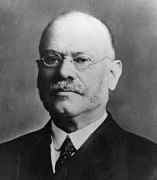Person: Peirce (3), Benjamin Osgood

Benjamin Osgood Peirce was an American mathematician who became an important figure in applied mathematics in the United States.
Mathematical Profile (Excerpt):
- has a vivid recollection of Peirce in his college days.
- At one time Peirce, Pine, Lefavour, and the two Lowells were all together in a course of elective mathematics given by Benjamin Peirce, then at the height of his fame.
- It is interesting to hear Mr Pine's observation that Peirce and Lefavour took criticism in docile fashion from their illustrious teacher, but that the Lowells always wanted to argue the point.
- Peirce began publishing papers, his first, written jointly with his friend Lefavour, was entitled On the effect of armatures on the magnetic state of electromagnets and appeared in 1875.
- Peirce was awarded a Parker Fellowship which allowed him to continue his studies in Europe.
- When this young man appeared he tried Peirce in Latin.
- Peirce's love of music meant that he had joined the choral society, the Riedelsche Verein, and attended many musical events where he had met Isamella.
- At this time Peirce was particularly interested in studying properties of magnetism.
- These years in Germany were particularly important for Peirce who learnt mathematical techniques used in theoretical physics, topics hardly studied at all in the United States at this time.
- In 1884 Peirce was promoted to Assistant Professor of Mathematics and Physics, working under Joseph Lovering (1813-1892) who was Hollis Professor of Mathematics and Natural Philosophy at Harvard, a post he had been appointed to in 1838.
- Peirce was assisted in developing the teaching of mathematical physics at Harvard by his colleague William Elwood Byerly (1849-1935).
- Together they taught calculus and its applications, constructing a two year course which Peirce and Byerly taught starting in alternate years.
- But the most notable course instituted by Peirce and shared by this pair of masterly teachers was that one in which Peirce treated the theory of the Newtonian potential function, and Byerly the theory of Fourier's series.
- Byerly's text Elements of the integral calculus was first published in 1881, while Peirce's text Elements of the theory of the Newtonian potential function was first published in 1886.
- As an indication of the cooperation of Peirce and Byerly on the two books, we note that Peirce published a table of integrals as a supplement to the edition which Byerly brought out in 1889.
- Peirce's A short table of integrals was a very popular work which soon became a book in its own right rather than a supplement.
- Joseph Lovering had retired in 1888 and Peirce was appointed to succeed him becoming Hollis Professor of Mathematics and Natural Philosophy.
- The extreme activity that Peirce began after his illness in 1900-02 continued until the spring of 1913 when again his health became so bad that he was forced to stop teaching before the end of the academic year.
- During his visit to Britain Peirce's health gave cause for concern, he suffered a minor stroke and had heart problems.
- Professor Peirce devoted much time to the study of this subject, and his work is marked by the great care he took in his experiments and by his thoroughgoing analysis of the details of the problems involved; it is an admirable example of the best type of experimental work.
Born 11 February 1854, Beverly, Massachusetts, USA. Died 14 January 1914, Cambridge, Massachusetts, USA.
View full biography at MacTutor
Tags relevant for this person:
Origin Usa
Thank you to the contributors under CC BY-SA 4.0! 

- Github:
-

- non-Github:
- @J-J-O'Connor
- @E-F-Robertson
References
Adapted from other CC BY-SA 4.0 Sources:
- O’Connor, John J; Robertson, Edmund F: MacTutor History of Mathematics Archive
